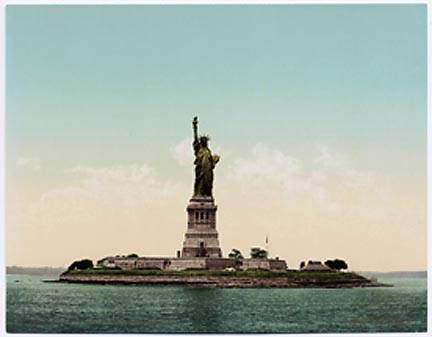FREE NEWS LINKS

HOME SEARCH
Updates & changes ongoing ....
---- Although this site is https-secure, we cannot guarantee that it or any provided links are safe; be sure your antivirus and other security systems are up to date.
Also see: Immigration; anti-semitism; The New Colossus; Emma Lazarus; France;
Jump to: 2017; 2018; 2019; 2020;

Statue of Liberty, original color before acquiring natural patina
Undated: The Statue of Liberty (Liberty Enlightening the World; French: La Liberté éclairant le monde) is a colossal neoclassical sculpture on Liberty Island in New York Harbor in New York, in the United States. The copper statue, a gift from the people of France to the people of the United States, was designed by French sculptor Frédéric Auguste Bartholdi and its metal framework was built by Gustave Eiffel. The statue was dedicated on October 28, 1886.
The Statue of Liberty is a figure of Libertas, a robed Roman liberty goddess. She holds a torch above her head with her right hand, and in her left hand carries a tabula ansata inscribed in Roman numerals with "JULY IV MDCCLXXVI" (July 4, 1776), the date of the U.S. Declaration of Independence. A broken chain lies at her feet as she walks forward. The statue became an icon of freedom and of the United States, and a national park tourism destination. It is a welcoming sight to immigrants arriving from abroad.
Bartholdi was inspired by a French law professor and politician, Édouard René de Laboulaye, who is said to have commented in 1865 that any monument raised to U.S. independence would properly be a joint project of the French and U.S. peoples. Because of the post-war instability in France, work on the statue did not commence until the early 1870s. In 1875, Laboulaye proposed that the French finance the statue and the U.S. provide the site and build the pedestal. Bartholdi completed the head and the torch-bearing arm before the statue was fully designed, and these pieces were exhibited for publicity at international expositions.
The torch-bearing arm was displayed at the Centennial Exposition in Philadelphia in 1876, and in Madison Square Park in Manhattan from 1876 to 1882. Fundraising proved difficult, especially for the Americans, and by 1885 work on the pedestal was threatened by lack of funds. Publisher Joseph Pulitzer, of the New York World, started a drive for donations to finish the project and attracted more than 120,000 contributors, most of whom gave less than a dollar. The statue was built in France, shipped overseas in crates, and assembled on the completed pedestal on what was then called Bedloe's Island. The statue's completion was marked by New York's first ticker-tape parade and a dedication ceremony presided over by President Grover Cleveland.
The statue was administered by the United States Lighthouse Board until 1901 and then by the Department of War; since 1933 it has been maintained by the National Park Service as part of the Statue of Liberty National Monument. Public access to the balcony around the torch has been barred since 1916.
https://en.wikipedia.org/wiki/Statue_of_Liberty
-- 2017 --
Back to top
May 24: How Do You Save the Statue of Liberty From Drowning?
Lady Liberty is a towering symbol of our national vulnerability to the changing planet.
In her current position, with her toes about 154 feet above the waterline, Lady Liberty is better protected than many of her human neighbors. In one extreme scenario posited by the website Climate Central, melting ice sheets in Antarctica would cause sea levels to rise roughly 12 feet by 2100. That would be enough to produce average high tides 2 feet above the flood level caused by Hurricane Sandy, which swamped Liberty Island and destroyed its electrical systems.
https://www.bloomberg.com/news/features/2017-05-24/saving-the-statue-of-liberty-from-climate-change
-- 2018 --
Back to top
June 20: Saving Lady Liberty: How Peter Max Helped Restore the Statue of Liberty
Iconic Pop artist Peter Max has several recurring images that he’s returned to throughout his prolific career, but perhaps none are more famous than the Statue of Liberty. Max has been enamored with the statue since ever completing his first portrait of it 42 years ago.
Standing at 305 feet tall, the Statue of Liberty is a symbol of freedom, optimism, and friendship among nations. Lady Liberty’s classic design is based on the Roman goddess Libertas, the embodiment of liberty.
However, in the early 1980s, the statue hardly resembled a goddess. It was cracked, crumbling, and in desperate need of restoration. Fortunately, its salvation came from an unlikely source—Max.
https://www.parkwestgallery.com/peter-max-statue-of-liberty/
July 12: Challenges Of Cleaning The Statue Of Liberty
The Statue of Liberty hasn’t had a bath in more than 130 years, according to an article on the AM New York website. And despite regular maintenance and a handful of restoration projects, the symbol of American freedom is plagued by a green hue — a direct result of not being washed.
It's difficult to tell now, but Lady Liberty is actually made of copper and was the color of an old penny when it first opened in 1886. Her look changed over time because as copper oxidizes it develops a green patina. That patina shields the statue from the extreme elements of New York Harbor, like high winds, salt water and air pollution.
Cleaning the green patina from the Statue of Liberty could do more harm than good, according to National Park Service spokesman Jerry Willis in a statement to AM New York. But that doesn't mean there are no maintenance chores.
A team of 24 caregivers from the National Park Service and several contractors maintain the statue and tend to groundskeeping, clear drainage grates, and keep the plumbing, electrical and HVAC systems working.
https://www.cleanlink.com/news/article/Challenges-Of-Cleaning-The-Statue-Of-Liberty--22628
November 15: Moving the Statue of Liberty's Original Torch
For nearly 100 years, this gold and copper marvel served as a beacon of freedom in the outstretched hand of Lady Liberty. On November 15, 2018, the Statue of Liberty’s original torch moved into its new home inside the Statue of Liberty Museum currently being built on Liberty Island. The torch had been removed from atop the monument in 1984, as part of the Statue’s centennial restoration project, and placed on display inside the Statue of Liberty’s pedestal. Led by The Statue of Liberty-Ellis Island Foundation and the U.S. Department of the Interior/National Park Service, a team of engineers disassembled the torch and relocated it from the monument’s pedestal across Liberty Island to the new museum site. Under the glow of the new torch and gold-gilded flame held by Lady Liberty since 1985, a special hydraulically stabilized transporter vehicle took the original torch 470 feet across the island before the torch was lifted by crane into the new museum.
The 3,600-pound original torch will be the centerpiece of the new Statue of Liberty Museum, a 26,000-square-foot museum that will celebrate the Statue of Liberty’s history, influence, and legacy in the world. Visitors will get an up-close view of the iconic symbol in its new home in the Inspiration Gallery, which features floor-to-ceiling glass panels overlooking the Statue of Liberty and Manhattan skyline. The museum will be free to visitors with the purchase of a ferry ticket to visit Liberty and Ellis Islands and is expected to open to the public in May 2019.
https://libertyellisfoundation.org/torchmove?ccd=Email-Series-1.CAMP20173
November 16: Over the years, the copper flame had been substantially altered in order to better light the torch. Initial efforts, which involved punching holes in the flame so it could be illuminated from within, had underwhelming results. So in 1916, sculptor Gutzon Borglum—the creator of Mount Rushmore—added amber glass panels to the design. But the window panes leaked, causing damage to the statue’s arm and ultimately necessitating its replacement.
The new torch replicated sculptor Frédéric Auguste Bartholdi’s original design, and even added 24-carat gold leaf gilding, an element of the artist’s vision that had been too expensive to execute at the time. In the decades since, the original torch has been on display in the museum inside the statue’s pedestal.
The torch was actually the first portion of the Statue of Liberty to arrive in New York after being shipped piecemeal across the ocean from France. After debuting at the World’s Fair in Philadelphia in 1876, it went on display in Madison Square Park as part of an effort to raise money to build a pedestal for the statue.
The arm and torch were closed to visitors in 1916 after German spies launched shrapnel into the statue as the result of an attack targeting the nearby Black Tom munitions depot. Black Tom Island has since become part of Liberty Island thanks to landfill expansion projects. Entering the torch requires climbing a 40-foot ladder, accessible only to staff.
https://news.artnet.com/art-world/statue-of-liberty-torch-moved-ahead-of-opening-of-new-museum-1397782
-- 2019 --
Back to top
-- 2020 --
Back to top
Webpage visitor counts provided by